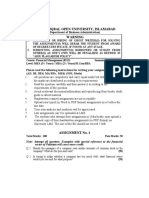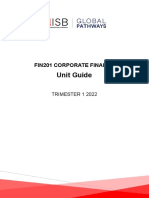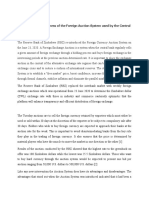Math1020 100
Math1020 100
Uploaded by
shaifghaniCopyright:
Available Formats
Math1020 100
Math1020 100
Uploaded by
shaifghaniOriginal Title
Copyright
Available Formats
Share this document
Did you find this document useful?
Is this content inappropriate?
Copyright:
Available Formats
Math1020 100
Math1020 100
Uploaded by
shaifghaniCopyright:
Available Formats
COURSE OUTLINE 1
Course Name BUSINESS MATHEMATICS II (2007-2008)
and Code MATH1020
Total Hours 45
Credits 3
Prerequisite(s) Business Mathematics I (MATH1010)
Corequisite(s)
Course Description
The purpose of the course is to provide the student with a mathematical basis for personal and business financial decisions.
Topics include: simple interest, simple discount, compound interest, annuities and their many applications including
amortization, sinking funds, Canadian mortgages and refinancing of loans. A Texas Instrument BAII “Plus” financial
calculator is required.
Course Outcomes
Successful completion of this course will enable the student to:
1. Solve business problems involving simple interest and promissory note discounting.
2. Solve business problems involving compound interest.
3. Solve business problems involving ordinary simple annuities.
4. Solve business problems involving general annuities especially as related to Canadian mortgages. Solve problems
involving amortization and sinking funds including the construction of schedules.
RETAIN THIS DOCUMENT FOR FUTUR E EDUCATIONAL\EMPLOYMENT USE
COURSE OUTLINE 2
Course Name BUSINESS MATHEMATICS II (2007-2008)
and Code MATH1020
Unit Outcomes Resources/Tests/Assignments
Successful completion of the following units will enable the student to: Text Business Mathematics in Canada
5th Ed.
1.0 Simple Interest
1.1 Solve for any one of interest, principal, time or rate given the other Chapter 6
three quantities.
1.2 Determine the time period using the BA2+ calculator.
1.3 Solve for maturity value, principal, rate or time given three other
quantities.
1.4 Present details of the amount and timing of payments in a time
diagram.
1.5 Calculate the equivalent value on any date of a single payment or
payment stream.
1.6 Calculate the size of equal loan payments or a final loan payment.
2.0 Simple Interest Applications Chapter 7
2.1 Calculate the interest paid on savings accounts and GIC’s.
2.2 State the Valuation Principle and use it to calculate the fair market
value of an investment providing specified future cash flows.
2.3 Calculate the market price and rate of return on commercial paper and
Treasury Bills.
2.4 Calculate the proceeds of interest and non-interest bearing promissory Test One
notes.
3.0 Compound Interest and Applications Chapter 8
3.1 Calculate the future value and present value in compound interest
applications.
3.2 Calculate the maturity value of compound interest GIC’s.
3.3 Calculate the price of strip bonds.
3.4 Calculate the e quivalent payment on any date for one or more
payments on other dates.
3.5 Calculate the economic value of a payment stream.
4.0 Compound Interest Further Topics Chapter 9
4.1 Calculate the periodic rate of interest.
4.2 Calculate the number of compounding periods.
4.3 Calculate effective and equivalent interest rates given a nominal rate
of interest.
4.4 Calculate annualized rates of return and growth. Test Two
COURSE OUTLINE 3
Course Name BUSINESS MATHEMATICS II (2007-2008)
and Code MATH1020
Unit Outcomes Resources/Tests/Assignments
5.0 Ordinary Annuities: Future Value and Present Value Chapter 10
5.1 Define and distinguish between ordinary simple annuities and
ordinary general annuities.
5.2 Calculate the future value and present value of ordinary annuities.
5.3 Calculate the present value and length of deferral period for a deferred
annuity.
5.4 Calculate the equivalent periodic interest rate for an ordinary general
annuity.
6.0 Ordinary Annuities: Payment Size, Term and Interest Rate Chapter 11
6.1 Calculate the payment size for ordinary and deferred annuities.
6.2 Calculate the number of payments for ordinary and deferred annuities.
6.3 Calculate the interest rate for ordinary annuities.
7.0 Perpetuities Chapter 12
7.1 Calculate the present value and rate of return to sustain ordinary
simple or general perpetuities.
7.2 Calculate the payment in a deferred general perpetuity.
8.0 Annuities Due Chapter 13
8.1 Calculate the future value and present value of annuities due.
8.2 Calculate the payment size, number of payments and interest rate for Test Three
annuities due.
9.0 Amortization of Loans Chapter 14
9.1 Calculate the outstanding principal balance after any payment using
the retrospective method.
9.2 Calculate a different final loan payment.
9.3 Calculate the interest and principal components of any loan payment.
9.4 Construct a loan’s amortization schedule.
9.5 Calculate mortgage payments for an original loan amount and a
renewal amount.
9.6 Calculate mortgage balances and amortization periods to reflect
prepayments of principal.
10.0 Bonds and Sinking Funds Chapter 15
10.1 Calculate the market price of a bond for any date.
10.2 Calculate the yield to maturity of a bond on an interest payment date.
10.3 Calculate a bond price on any date.
10.4 Construct a complete sinking fund schedule. Test Four
COURSE OUTLINE 4
Course Name BUSINESS MATHEMATICS II (2007-2008)
and Code MATH1020
Required Student Resources (Including textbooks and workbooks)
Jerome, F. Ernest. Business Mathematics in Canada (5th Edition). Irwin 2005 (including Lyryx Interactive Pin Code).
(ISBN 007-098-6509). Day School
Jerome, F. Ernest. Business Mathematics in Canada (5th Edition). Irwin 2005 (ISBN 007-091-8643). Night School
Calculator – Texas Instruments BAII+ is required (Pre-programmed financial calculator).
Optional Resources
Handouts supplied by the professor
Instructor’s Solution Manual – On reserve in LRC
Student Solution Manual – available for purchase in bookstore
Evaluation
In order to successfully complete this course, the student is required to meet the following evaluation criteria:
Achieve a weighted average grade of ≥ 55% based on the following evaluation tools/methods:
Tests 90%
Assignments 10%
100%
NOTES:
1. Assignments may be a combination of paper-based and online; Online assignments must be completed by the posted
closing date.
2. No formulas will be given on tests or exams
3. Aids such as formula sheets are not permitted.
4. BAII Plus is the only calculator permitted on tests or exam. No other calculator will be allowed.
5. Dictionaries, electronic translators and electronic organizers are not permitted on tests or exams.
Other
The instructional mode is through lectures. Due to changing business practices and/or time constraints some topics may be
covered briefly or altered.
All tests and examinations must be written on the dates and at the times scheduled. Students who miss these tests or
examinations will automatically be given zero grades unless they can defend their absences with medical certificates, death
certificates or court documents. Students are responsible for keeping all returned assignments and tests in the event of
disputes over recorded marks. A student who misses a class is responsible for obtaining any handouts and information on
course content, assignments, due dates, test dates, etc.
Conestoga College is committed to providing academic accommodations for students with documented disabilities. Please
contact the Disability Services Office.
A course requirement sheet will be distributed at the beginning of the course and will be referred to in conjunction with this
course outline.
Prepared by Brian Tozer, Carol Leppinen, Tracy Worswick, Oded Tal
School Business Campus Doon
Date 2007-06-30 Previous Outline Dated 2006-06-30
BUS\CO\2007\MATH1020(100) © Conestoga ITAL
You might also like
- Global Management and Politics Financial Reporting and Performance Measurement Prof. Jonathan BerkovitchDocument4 pagesGlobal Management and Politics Financial Reporting and Performance Measurement Prof. Jonathan BerkovitchFanny BozziNo ratings yet
- Institute of Actuaries of India: Subject CM1 - Actuarial Mathematics Core Principles For 2022 ExaminationsDocument7 pagesInstitute of Actuaries of India: Subject CM1 - Actuarial Mathematics Core Principles For 2022 Examinationssankar KNo ratings yet
- Chapter 14 - Test BankDocument44 pagesChapter 14 - Test Bankjdiaz_64624796% (23)
- Value Investing Quotes (With Links)Document145 pagesValue Investing Quotes (With Links)BCarr038100% (1)
- Quibuyen S A Nation Aborted Summary NotesDocument5 pagesQuibuyen S A Nation Aborted Summary NotesJiyuNo ratings yet
- COMM 308 Course Outline - Summer 2 2021 - Section CADocument14 pagesCOMM 308 Course Outline - Summer 2 2021 - Section CAOlivia ZakemNo ratings yet
- Financial Accounting 1 Course OutlineDocument3 pagesFinancial Accounting 1 Course OutlineAbdi Mucee TubeNo ratings yet
- 2019 FIN13H Corporate Finance 2 Syllabus Revised 12.08.2024Document5 pages2019 FIN13H Corporate Finance 2 Syllabus Revised 12.08.2024Lê SơnNo ratings yet
- ACCT5170 Syllabus - 2023Document7 pagesACCT5170 Syllabus - 2023bafsvideo4No ratings yet
- A. Financial Management 13Document5 pagesA. Financial Management 13Honey EditsNo ratings yet
- FYBCOM SyllabusDocument39 pagesFYBCOM Syllabusvalotard69No ratings yet
- Module Handbook 2017/2018: Banking Academy of Vietnam Finance FacultyDocument6 pagesModule Handbook 2017/2018: Banking Academy of Vietnam Finance FacultyVũ Thị Lan HươngNo ratings yet
- BUS 230 Intro To Finance Begrakyan Fall 2022 BDocument11 pagesBUS 230 Intro To Finance Begrakyan Fall 2022 BOvsanna HovhannisyanNo ratings yet
- School of Business & Economics Department of Accounting & FinanceDocument4 pagesSchool of Business & Economics Department of Accounting & FinanceMd JonaidNo ratings yet
- Payroll PDFDocument15 pagesPayroll PDFRoach0% (1)
- Fin222 So s12019 Iicsj - ApprovedDocument13 pagesFin222 So s12019 Iicsj - ApprovedraphaelrachelNo ratings yet
- Syllabus-Advanced Financial AccountingDocument8 pagesSyllabus-Advanced Financial AccountingAndualem Zenebe100% (1)
- Financial Markets and Valuation: Course PurposeDocument7 pagesFinancial Markets and Valuation: Course PurposeVishakha ChopraNo ratings yet
- Khalifa Al Blooshi (1) FinalDocument11 pagesKhalifa Al Blooshi (1) FinalArushi GuptaNo ratings yet
- UT Dallas Syllabus For Aim4336.001.11s Taught by Richard Bowen III (rxb073100)Document7 pagesUT Dallas Syllabus For Aim4336.001.11s Taught by Richard Bowen III (rxb073100)UT Dallas Provost's Technology GroupNo ratings yet
- 2MINVESDocument3 pages2MINVESMynn Ü DeLa CruzNo ratings yet
- Advanced Financial Accounting I Course Outline (1)Document3 pagesAdvanced Financial Accounting I Course Outline (1)Yani 28No ratings yet
- Course Outline Intermediate and Advanced Accounting1 Revised 2Document5 pagesCourse Outline Intermediate and Advanced Accounting1 Revised 2Amde GetuNo ratings yet
- ENGG 3240 Engineering Economics: 1 Course DetailsDocument9 pagesENGG 3240 Engineering Economics: 1 Course DetailsIryn JoieNo ratings yet
- Cm1 Syllabus FinalDocument9 pagesCm1 Syllabus FinalMtaki deusNo ratings yet
- Upang Cea Common Eco017Document33 pagesUpang Cea Common Eco017Hannah TristanaNo ratings yet
- Tenenbein Statub27 Statgb2309 Spring23Document6 pagesTenenbein Statub27 Statgb2309 Spring23Hauser WinchesterNo ratings yet
- Syllabus 2 2023Document4 pagesSyllabus 2 2023Dinesh KumarNo ratings yet
- Modern Business MathsDocument2 pagesModern Business MathsRashmi KrNo ratings yet
- Course Specification-Actu 361 Eng Revised 2016Document9 pagesCourse Specification-Actu 361 Eng Revised 2016عبدالله الحربيNo ratings yet
- UT Dallas Syllabus For Fin6321.001.11s Taught by George DeCourcy (Gad075000)Document4 pagesUT Dallas Syllabus For Fin6321.001.11s Taught by George DeCourcy (Gad075000)UT Dallas Provost's Technology GroupNo ratings yet
- Corporate Finance - KS KimDocument5 pagesCorporate Finance - KS Kim01202750693No ratings yet
- Booklet 2Document127 pagesBooklet 2alok pandeyNo ratings yet
- Chapter 2 - Factors How Time and Interest Affect MoneyDocument62 pagesChapter 2 - Factors How Time and Interest Affect MoneyBejong BoyNo ratings yet
- 2. PGP CF 2024 Course OutlineDocument4 pages2. PGP CF 2024 Course OutlineSouradeep GhoshNo ratings yet
- Finance Module OutlineDocument5 pagesFinance Module OutlinemihsovyaNo ratings yet
- HUB - Corporate Finance 1Document64 pagesHUB - Corporate Finance 1Trần Bảo Tiên LươngNo ratings yet
- CF SyllabusDocument19 pagesCF SyllabusraithebestNo ratings yet
- Level 3 Certificate in Accounting: SyllabusDocument16 pagesLevel 3 Certificate in Accounting: SyllabusCharles MK ChanNo ratings yet
- 2022 10 Exam FM SyllabusDocument8 pages2022 10 Exam FM SyllabusPeterNo ratings yet
- Course Outline Financial Modeling PGDMDocument5 pagesCourse Outline Financial Modeling PGDMDisha DahiyaNo ratings yet
- ECN201 Syllabus Malm OL CRN41162Document11 pagesECN201 Syllabus Malm OL CRN41162Evaylyn BenitezNo ratings yet
- Indian Institute of Management, Kozhikode: Course Term Credits InstructorDocument2 pagesIndian Institute of Management, Kozhikode: Course Term Credits InstructorAnjali LakraNo ratings yet
- 2022 2023 - Fina 6013Document8 pages2022 2023 - Fina 6013Shanawaz KhanNo ratings yet
- Allama Iqbal Open University, Islamabad Warning: (Department of Business Administration)Document7 pagesAllama Iqbal Open University, Islamabad Warning: (Department of Business Administration)NadeemAdilNo ratings yet
- IAI CM1 Syllabus 2024Document7 pagesIAI CM1 Syllabus 2024agnivodeystat1068No ratings yet
- SyllabusDocument9 pagesSyllabusMichael KirschNo ratings yet
- UT Dallas Syllabus For Ba3341.521 06u Taught by Amal El-Ashmawi (Ahe013000)Document7 pagesUT Dallas Syllabus For Ba3341.521 06u Taught by Amal El-Ashmawi (Ahe013000)UT Dallas Provost's Technology GroupNo ratings yet
- BUS20269-FM - (2020-21B) Course OutlineDocument11 pagesBUS20269-FM - (2020-21B) Course Outlinetsangbobbi13No ratings yet
- CF Technical Foundations V18 SyllabusDocument19 pagesCF Technical Foundations V18 Syllabusatanganajean72No ratings yet
- CF Technical Foundations V17 SyllabusDocument19 pagesCF Technical Foundations V17 Syllabusatanganajean72No ratings yet
- Cf Technical Foundations Syllabus v17Document19 pagesCf Technical Foundations Syllabus v17raithebestNo ratings yet
- Course Out Line TalilaDocument5 pagesCourse Out Line TalilatalilaNo ratings yet
- Unit Guide - Corporate FinanceDocument10 pagesUnit Guide - Corporate FinanceAn Pham ThuyNo ratings yet
- Sjerris@sfsu - Edu: Intermediate Financial Accounting Accounting 302Document6 pagesSjerris@sfsu - Edu: Intermediate Financial Accounting Accounting 302ArshSinghNo ratings yet
- FM Course OutlineDocument8 pagesFM Course OutlineTabassamRashidNo ratings yet
- Corporate FinanceDocument2 pagesCorporate FinanceS M Islamul HaqueNo ratings yet
- BUS2201-S12 Outline 2022-23 T2Document6 pagesBUS2201-S12 Outline 2022-23 T2JOANNA LAMNo ratings yet
- m405 01 2195443yy5t6t25Document3 pagesm405 01 2195443yy5t6t25Orlan RodriguezNo ratings yet
- North Hennepin Community College BUS 1400: Business MathematicsDocument2 pagesNorth Hennepin Community College BUS 1400: Business MathematicsHenziNo ratings yet
- 2022 FIN01H CF1 Syllabus AccountingDocument17 pages2022 FIN01H CF1 Syllabus AccountingMít MítNo ratings yet
- Schaum's Outline of Intermediate Accounting II, 2edFrom EverandSchaum's Outline of Intermediate Accounting II, 2edRating: 5 out of 5 stars5/5 (1)
- Evaluate The Effectiveness of The Foreign Auction System Used by The Central Bank in ZimbabweDocument4 pagesEvaluate The Effectiveness of The Foreign Auction System Used by The Central Bank in Zimbabwenever nyatsineNo ratings yet
- Spring ProtectionDocument6 pagesSpring ProtectionOxfamNo ratings yet
- CIR Vs Filinvest Development CorpoDocument18 pagesCIR Vs Filinvest Development CorpoGabby ElardoNo ratings yet
- Prod End-Of-life Notice 1112 ACSDocument3 pagesProd End-Of-life Notice 1112 ACSmdasilva779944No ratings yet
- Ghantasala Mini SonglistDocument13 pagesGhantasala Mini SonglistHarish PakalaNo ratings yet
- 17799-Article Text-61863-1-10-20220617Document12 pages17799-Article Text-61863-1-10-20220617dewikimtia578No ratings yet
- A Blast From The Past: A Research Study of Philippines' Childhood From Now and ThenDocument9 pagesA Blast From The Past: A Research Study of Philippines' Childhood From Now and ThenPrincess RomanNo ratings yet
- 1 21stCL-Q1-W5 With CoverDocument23 pages1 21stCL-Q1-W5 With CoverVictoria De Los SantosNo ratings yet
- Will Kymlicka's Views On Multicultural Citizenship: (I) Self-Government RightsDocument2 pagesWill Kymlicka's Views On Multicultural Citizenship: (I) Self-Government Rightssurbhi sharmaNo ratings yet
- Abdul Sattar EdhiDocument15 pagesAbdul Sattar EdhiRabia TabassumNo ratings yet
- Online Recruitment SystemDocument39 pagesOnline Recruitment SystemEmmanuel Lewa100% (1)
- Module 6 Quiz A (MO 6.1-6.3, CO 6) - SU2020 MBA 621-QL Topics Corporate FinanceDocument10 pagesModule 6 Quiz A (MO 6.1-6.3, CO 6) - SU2020 MBA 621-QL Topics Corporate FinanceLillaNo ratings yet
- Earth & Mars - R.K.murthyDocument144 pagesEarth & Mars - R.K.murthytvspriyaNo ratings yet
- United States v. Stanley B. Hoss, JR., Robert W. Duggan, District Attorney of Allegheny County, Representing The Commonwealth of Pennsylvania, 426 F.2d 291, 3rd Cir. (1970)Document2 pagesUnited States v. Stanley B. Hoss, JR., Robert W. Duggan, District Attorney of Allegheny County, Representing The Commonwealth of Pennsylvania, 426 F.2d 291, 3rd Cir. (1970)Scribd Government DocsNo ratings yet
- Ceiling BoysDocument63 pagesCeiling BoysSidNo ratings yet
- The Innocent HeroDocument5 pagesThe Innocent Heroapi-3779224100% (2)
- Bridging The Bay of Bengal - Toward A Stronger BIMSTEC - Carnegie India - Carnegie Endowment For International Peace PDFDocument30 pagesBridging The Bay of Bengal - Toward A Stronger BIMSTEC - Carnegie India - Carnegie Endowment For International Peace PDFBishadNo ratings yet
- James Brannigan ResumeDocument2 pagesJames Brannigan ResumeSureshkumaryadavNo ratings yet
- Ian Stewart - 28-03-16 - Tumbao PDFDocument9 pagesIan Stewart - 28-03-16 - Tumbao PDFARITOSOUL341100% (1)
- Online Content / Fatima Al Qadiri, Tony Arcabascio, Hennessy X Futura 2000.Document5 pagesOnline Content / Fatima Al Qadiri, Tony Arcabascio, Hennessy X Futura 2000.lizzyjjjjNo ratings yet
- Ab Urbe Condita - Liber IDocument2 pagesAb Urbe Condita - Liber ICamilla LalliNo ratings yet
- Western Civilization - A Concise History - Volume 3Document276 pagesWestern Civilization - A Concise History - Volume 3Yash TandonNo ratings yet
- B InggrisDocument2 pagesB InggrisJona ThanNo ratings yet
- 09 Homework 1Document5 pages09 Homework 1anjineth lapulapuNo ratings yet
- Chapter 4&5 Solicitation Planning, Evaluation & SelectionDocument36 pagesChapter 4&5 Solicitation Planning, Evaluation & SelectionMitku AssefaNo ratings yet
- Lecture 5 Palliative CareDocument15 pagesLecture 5 Palliative Carephoto copyhemnNo ratings yet
- School Of: Dr. B R Ambedkar Schools of Specialised ExcellenceDocument1 pageSchool Of: Dr. B R Ambedkar Schools of Specialised Excellencekusumverma449No ratings yet
























































































